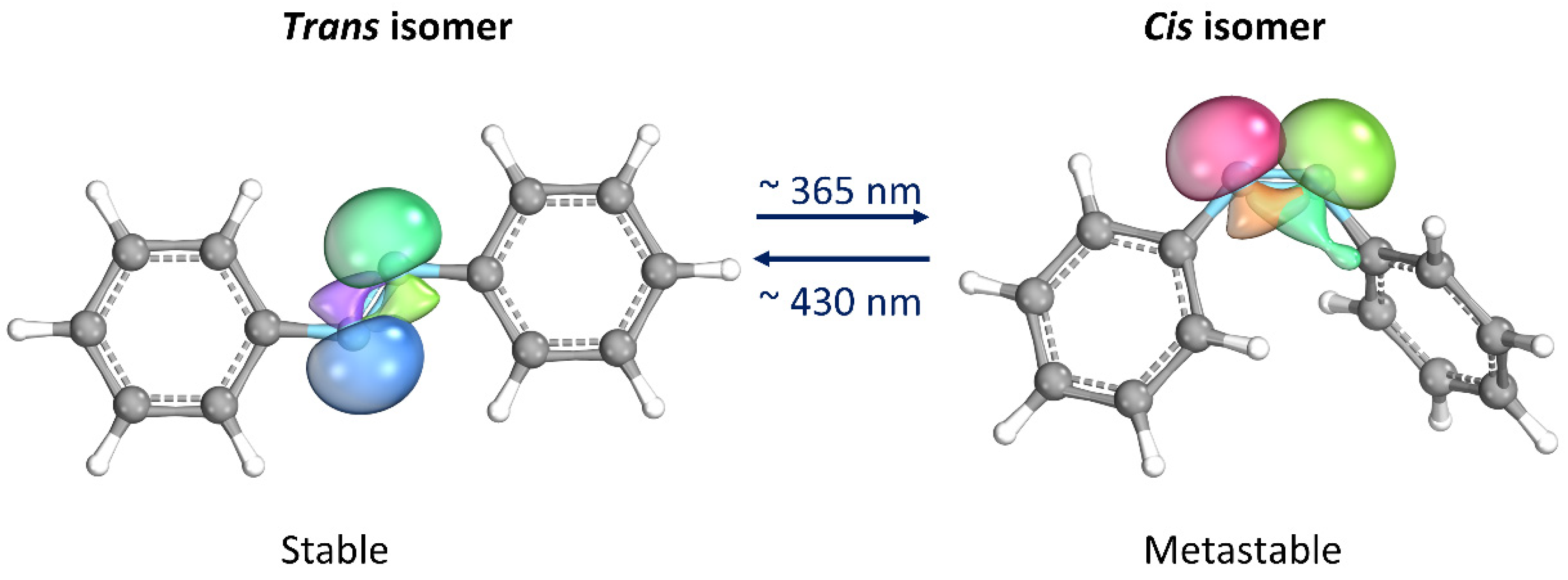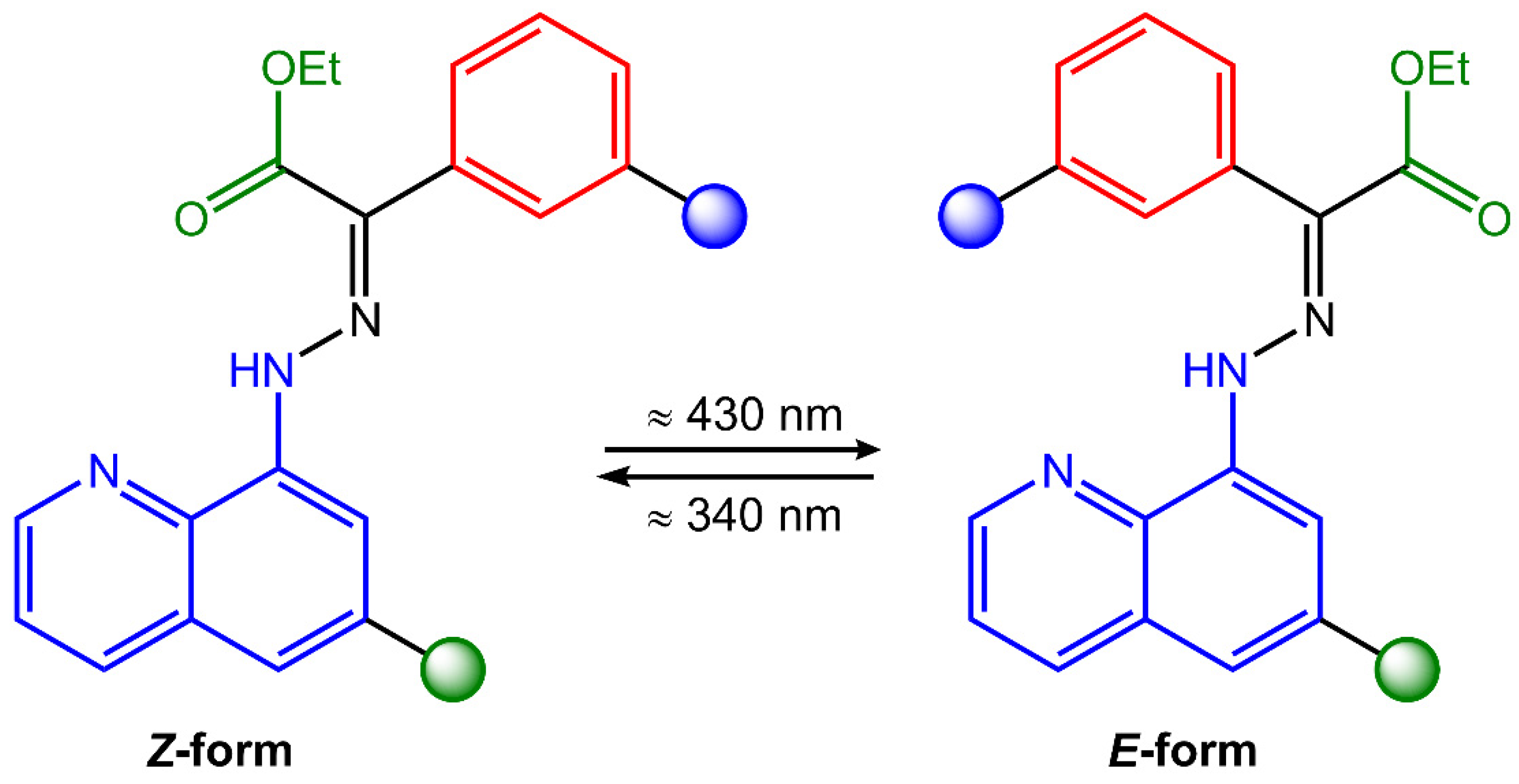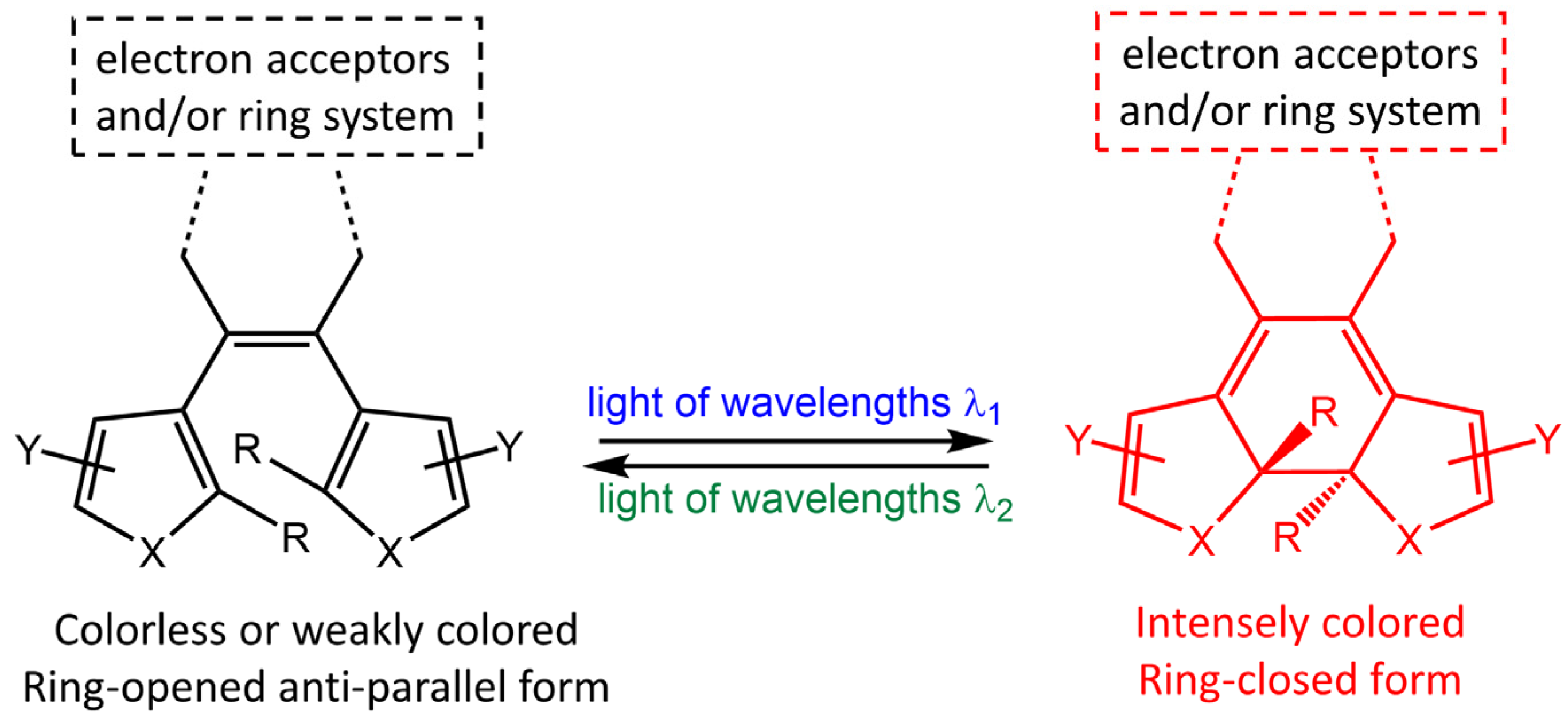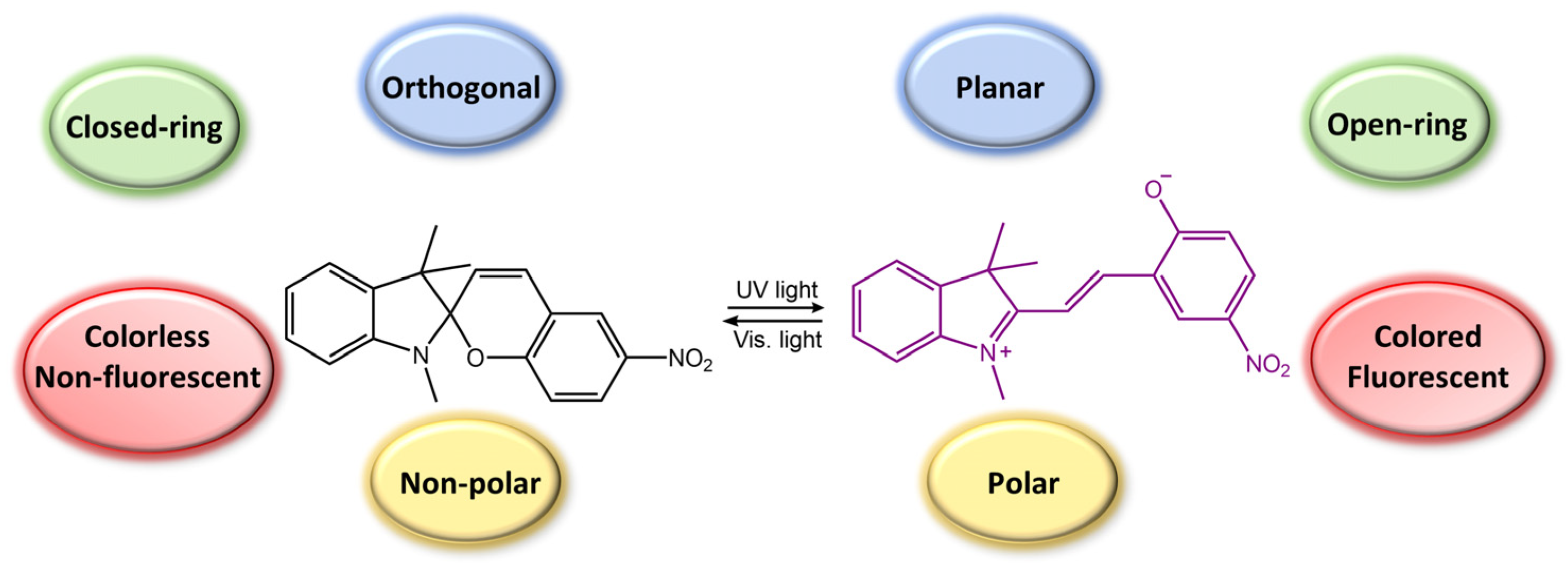Recent Progress in Photoresponsive Biomaterials
Abstract
:1. Introduction
2. Azobenzene Photoswitches
2.1. Azobenzene-Based Hydrogels and Particles
2.2. Azobenzene-Based Films and Coatings
2.3. Azobenzene-Based MOFs
3. Hydrazone Photoswitches
3.1. Hydrazone-Based Hydrogels and Particles
3.2. Hydrazone-Based Films and Coatings
4. Diarylethene Photoswitches
4.1. Diarylethene-Based Nanoparticles
4.2. Diarylethene-Based Films and Coatings
4.3. Diarylethene-Based MOFs
5. Spiropyran Photoswitches
5.1. Spiropyran-Based Hydrogels and Particles
5.2. Spiropyran-Based Films and Coatings
5.3. Spiropyran-Based MOFs
6. Comparison among the Different Systems
7. Conclusions
Author Contributions
Funding
Institutional Review Board Statement
Informed Consent Statement
Data Availability Statement
Conflicts of Interest
References
- Chang, V.Y.; Fedele, C.; Priimagi, A.; Shishido, A.; Barrett, C.J. Photoreversible soft azo dye materials: Toward optical control of bio-interfaces. Adv. Opt. Mater. 2019, 7, 1900091. [Google Scholar] [CrossRef]
- Keyvan Rad, J.; Balzade, Z.; Mahdavian, A.R. Spiropyran-based advanced photoswitchable materials: A fascinating pathway to the future stimuli-responsive devices. J. Photochem. Photobiol. C Photochem. Rev. 2022, 51, 100487. [Google Scholar] [CrossRef]
- Quan, J.; Guo, Y.; Ma, J.; Long, D.; Wang, J.; Zhang, L.; Sun, Y.; Dhinakaran, M.K.; Li, H. Light-responsive nanochannels based on the supramolecular host–guest system. Front. Chem. 2022, 10, 986908. [Google Scholar] [CrossRef] [PubMed]
- Di Martino, M.; Marrafino, F.; Diana, R.; Iannelli, P.; Concilio, S. Fluorescent Probes for Applications in Bioimaging. In Advances in Bionanomaterials II: Selected Papers, Proceedings of the 3rd International Conference on Bio and Nanomaterials, BIONAM 2019, Mediterranean Sea, Italy, 29 September–3 October 2019; Springer: Berlin/Heidelberg, Germany, 2020; pp. 243–258. [Google Scholar]
- Welleman, I.M.; Hoorens, M.W.H.; Feringa, B.L.; Boersma, H.H.; Szymański, W. Photoresponsive molecular tools for emerging applications of light in medicine. Chem. Sci. 2020, 11, 11672–11691. [Google Scholar] [CrossRef] [PubMed]
- Yang, Z.; Liu, Z.; Yuan, L. Recent advances of photoresponsive supramolecular switches. Asian J. Org. Chem. 2021, 10, 74–90. [Google Scholar] [CrossRef]
- Wang, G.; Zhang, J. Photoresponsive molecular switches for biotechnology. J. Photochem. Photobiol. C Photochem. Rev. 2012, 13, 299–309. [Google Scholar] [CrossRef]
- Volarić, J.; Szymanski, W.; Simeth, N.A.; Feringa, B.L. Molecular photoswitches in aqueous environments. Chem. Soc. Rev. 2021, 50, 12377–12449. [Google Scholar] [CrossRef]
- Pearson, S.; Feng, J.; del Campo, A. Lighting the path: Light delivery strategies to activate photoresponsive biomaterials in vivo. Adv. Funct. Mater. 2021, 31, 2105989. [Google Scholar] [CrossRef]
- Xiong, X.; del Campo, A.; Cui, J. Chapter 4—Photoresponsive Polymers. In Smart Polymers and their Applications, 2nd ed.; Aguilar, M.R., San Román, J., Eds.; Woodhead Publishing: Sawston, UK, 2019; pp. 87–153. [Google Scholar]
- Diana, R.; Panunzi, B.; Shikler, R.; Nabha, S.; Caruso, U. Highly efficient dicyano-phenylenevinylene fluorophore as polymer dopant or zinc-driven self-assembling building block. Inorg. Chem. Commun. 2019, 104, 145–149. [Google Scholar] [CrossRef]
- Hartley, G.S. The cis-form of azobenzene. Nature 1937, 140, 281. [Google Scholar] [CrossRef]
- Di Martino, M.; Sessa, L.; Di Matteo, M.; Panunzi, B.; Piotto, S.; Concilio, S. Azobenzene as Antimicrobial Molecules. Molecules 2022, 27, 5643. [Google Scholar] [CrossRef] [PubMed]
- Diana, R.; Caruso, U.; Piotto, S.; Concilio, S.; Shikler, R.; Panunzi, B. Spectroscopic behaviour of two novel azobenzene fluorescent dyes and their polymeric blends. Molecules 2020, 25, 1368. [Google Scholar] [CrossRef] [PubMed]
- Diana, R.; Panunzi, B.; Concilio, S.; Marrafino, F.; Shikler, R.; Caruso, T.; Caruso, U. The Effect of Bulky Substituents on Two π-Conjugated Mesogenic Fluorophores. Their Organic Polymers and Zinc-Bridged Luminescent Networks. Polymers 2019, 11, 1379. [Google Scholar] [CrossRef]
- Jerca, F.A.; Jerca, V.V.; Hoogenboom, R. Advances and opportunities in the exciting world of azobenzenes. Nat. Rev. Chem. 2022, 6, 51–69. [Google Scholar] [CrossRef]
- Knizia, G. Intrinsic Atomic Orbitals: An Unbiased Bridge between Quantum Theory and Chemical Concepts. J. Chem. Theory Comput. 2013, 9, 4834–4843. [Google Scholar] [CrossRef] [PubMed]
- Piotto, S.; Concilio, S.; Sessa, L.; Diana, R.; Torrens, G.; Juan, C.; Caruso, U.; Iannelli, P. Synthesis and Antimicrobial Studies of New Antibacterial Azo-Compounds Active against Staphylococcus aureus and Listeria monocytogenes. Molecules 2017, 22, 1372. [Google Scholar] [CrossRef] [PubMed]
- Piotto, S.; Concilio, S.; Sessa, L.; Porta, A.; Calabrese, E.C.; Zanfardino, A.; Varcamonti, M.; Iannelli, P. Small azobenzene derivatives active against bacteria and fungi. Eur. J. Med. Chem. 2013, 68, 178–184. [Google Scholar] [CrossRef] [PubMed]
- Sessa, L.; Concilio, S.; Iannelli, P.; De Santis, F.; Porta, A.; Piotto, S. Antimicrobial Azobenzene Compounds and Their Potential Use in Biomaterials. In AIP Conference Proceedings; AIP Publishing LLC: Melville, NY, USA, 2016; p. 020018. [Google Scholar]
- Sessa, L.; Concilio, S.; Walde, P.; Robinson, T.; Dittrich, P.S.; Porta, A.; Panunzi, B.; Caruso, U.; Piotto, S. Study of the Interaction of a Novel Semi-Synthetic Peptide with Model Lipid Membranes. Membranes 2020, 10, 294. [Google Scholar] [CrossRef]
- Concilio, S.; Sessa, L.; Petrone, A.M.; Porta, A.; Diana, R.; Iannelli, P.; Piotto, S. Structure Modification of an Active Azo-Compound as a Route to New Antimicrobial Compounds. Molecules 2017, 22, 875. [Google Scholar] [CrossRef]
- Echeverria, C.; Fernandes, S.N.; Godinho, M.H.; Borges, J.P.; Soares, P.I.P. Functional Stimuli-Responsive Gels: Hydrogels and Microgels. Gels 2018, 4, 54. [Google Scholar] [CrossRef]
- Su, X.; Xiao, C.; Hu, C. Facile preparation and dual responsive behaviors of starch-based hydrogel containing azo and carboxylic groups. Int. J. Biol. Macromol. 2018, 115, 1189–1193. [Google Scholar] [CrossRef] [PubMed]
- Dai, L.; Lu, J.; Kong, F.; Liu, K.; Wei, H.; Si, C. Reversible photo-controlled release of bovine serum albumin by azobenzene-containing cellulose nanofibrils-based hydrogel. Adv. Compos. Hybrid Mater. 2019, 2, 462–470. [Google Scholar] [CrossRef]
- Zhao, F.; Bonasera, A.; Nöchel, U.; Behl, M.; Bléger, D. Reversible modulation of elasticity in fluoroazobenzene-containing hydrogels using green and blue light. Macromol. Rapid Commun. 2018, 39, 1700527. [Google Scholar] [CrossRef] [PubMed]
- Nie, C.; Liu, C.; Sun, S.; Wu, S. Visible-Light-Controlled Azobenzene-Cyclodextrin Host-Guest Interactions for Biomedical Applications and Surface Functionalization. ChemPhotoChem 2021, 5, 893–901. [Google Scholar] [CrossRef]
- Kim, Y.; Jeong, D.; Shinde, V.V.; Hu, Y.; Kim, C.; Jung, S. Azobenzene-grafted carboxymethyl cellulose hydrogels with photo-switchable, reduction-responsive and self-healing properties for a controlled drug release system. Int. J. Biol. Macromol. 2020, 163, 824–832. [Google Scholar] [CrossRef]
- Rosales, A.M.; Rodell, C.B.; Chen, M.H.; Morrow, M.G.; Anseth, K.S.; Burdick, J.A. Reversible control of network properties in azobenzene-containing hyaluronic acid-based hydrogels. Bioconjugate Chem. 2018, 29, 905–913. [Google Scholar] [CrossRef] [PubMed]
- Gao, F.; Bi, Z.; Wang, S.; Zhao, Z.; Dong, Y.; Li, X. An amphiphilic azobenzene derivative as a crosslinker in the construction of smart supramacromolecular hydrogels. Colloids Surf. A Physicochem. Eng. Asp. 2022, 647, 129088. [Google Scholar] [CrossRef]
- Salzano de Luna, M.; Marturano, V.; Manganelli, M.; Santillo, C.; Ambrogi, V.; Filippone, G.; Cerruti, P. Light-responsive and self-healing behavior of azobenzene-based supramolecular hydrogels. J. Colloid Interface Sci. 2020, 568, 16–24. [Google Scholar] [CrossRef]
- Mandl, G.A.; Rojas-Gutierrez, P.A.; Capobianco, J.A. A NIR-responsive azobenzene-based supramolecular hydrogel using upconverting nanoparticles. Chem. Commun. 2018, 54, 5847–5850. [Google Scholar] [CrossRef]
- Koryakina, I.; Kuznetsova, D.S.; Zuev, D.A.; Milichko, V.A.; Timin, A.S.; Zyuzin, M.V. Optically responsive delivery platforms: From the design considerations to biomedical applications. Nanophotonics 2020, 9, 39–74. [Google Scholar] [CrossRef]
- Miyata, T.; Namera, T.; Liu, Y.; Kawamura, A.; Yamaoka, T. Photoresponsive behaviour of zwitterionic polymer particles with photodimerizable groups on their surfaces. J. Mater. Chem. B 2022, 10, 2637–2648. [Google Scholar] [CrossRef] [PubMed]
- Zhao, T.; Wang, P.; Li, Q.; Al-Khalaf, A.A.; Hozzein, W.N.; Zhang, F.; Li, X.; Zhao, D. Near-infrared triggered decomposition of nanocapsules with high tumor accumulation and stimuli responsive fast elimination. Angew. Chem. Int. Ed. 2018, 57, 2611–2615. [Google Scholar] [CrossRef]
- Zhou, T.; Pliss, A.; Chen, Y.; Kuzmin, A.N.; Prasad, P.N.; Qu, J. A dual mode nanophotonics concept for in situ activation of brain immune cells using a photoswitchable yolk-shell upconversion nanoformulation. Nanomed. Nanotechnol. Biol. Med. 2020, 29, 102279. [Google Scholar] [CrossRef] [PubMed]
- Bian, Q.; Chen, S.; Xing, Y.; Yuan, D.; Lv, L.; Wang, G. Host-guest self-assembly toward reversible visible-light-responsive switching for bacterial adhesion. Acta Biomater. 2018, 76, 39–45. [Google Scholar] [CrossRef] [PubMed]
- Ni, Y.; Zhang, D.; Wang, Y.; He, X.; He, J.; Wu, H.; Yuan, J.; Sha, D.; Che, L.; Tan, J.; et al. Host–Guest Interaction-Mediated Photo/Temperature Dual-Controlled Antibacterial Surfaces. ACS Appl. Mater. Interfaces 2021, 13, 14543–14551. [Google Scholar] [CrossRef] [PubMed]
- Zheng, S.Y.; Ni, Y.; Zhou, J.; Gu, Y.; Wang, Y.; Yuan, J.; Wang, X.; Zhang, D.; Liu, S.; Yang, J. Photo-switchable supramolecular comb-like polymer brush based on host–guest recognition for use as antimicrobial smart surface. J. Mater. Chem. B 2022, 10, 3039–3047. [Google Scholar] [CrossRef]
- Piotto, S.; Concilio, S.; Sessa, L.; Iannelli, P.; Porta, A.; Calabrese, E.C.; Galdi, M.R.; Incarnato, L. Novel antimicrobial polymer films active against bacteria and fungi. Polym. Compos. 2013, 34, 1489–1492. [Google Scholar] [CrossRef]
- Concilio, S.; Piotto, S.; Sessa, L.; Iannelli, P.; Porta, A.; Calabrese, E.; Galdi, M.; Incarnato, L. Antimicrobial polymer films for food packaging. In AIP Conference Proceedings; American Institute of Physics: College Park, MD, USA, 2012; pp. 256–258. [Google Scholar]
- Marturano, V.; Bizzarro, V.; Ambrogi, V.; Cutignano, A.; Tommonaro, G.; Abbamondi, G.R.; Giamberini, M.; Tylkowski, B.; Carfagna, C.; Cerruti, P. Light-Responsive Nanocapsule-Coated Polymer Films for Antimicrobial Active Packaging. Polymers 2019, 11, 68. [Google Scholar] [CrossRef]
- Xie, K.P.; Ruan, Z.Y.; Lyu, B.H.; Chen, X.X.; Zhang, X.W.; Huang, G.Z.; Chen, Y.C.; Ni, Z.P.; Tong, M.L. Guest-Driven Light-Induced Spin Change in an Azobenzene Loaded Metal–Organic Framework. Angew. Chem. 2021, 133, 27350–27356. [Google Scholar] [CrossRef]
- Kanj, A.B.; Müller, K.; Heinke, L. Stimuli-responsive metal-organic frameworks with photoswitchable azobenzene side groups. Macromol. Rapid Commun. 2018, 39, 1700239. [Google Scholar] [CrossRef]
- Drake, H.F.; Day, G.S.; Xiao, Z.; Zhou, H.-C.; Ryder, M.R. Light-induced switchable adsorption in azobenzene-and stilbene-based porous materials. Trends Chem. 2022, 4, 32–47. [Google Scholar] [CrossRef]
- Prasetya, N.; Ladewig, B.P. New Azo-DMOF-1 MOF as a Photoresponsive Low-Energy CO2 Adsorbent and Its Exceptional CO2/N2 Separation Performance in Mixed Matrix Membranes. ACS Appl. Mater. Interfaces 2018, 10, 34291–34301. [Google Scholar] [CrossRef]
- Jiang, Y.; Tan, P.; Qi, S.C.; Liu, X.Q.; Yan, J.H.; Fan, F.; Sun, L.B. Metal–organic frameworks with target-specific active sites switched by photoresponsive motifs: Efficient adsorbents for tailorable CO2 capture. Angew. Chem. Int. Ed. 2019, 58, 6600–6604. [Google Scholar] [CrossRef] [PubMed]
- Chen, X.; Fang, S.; Xue, P.; Huang, J.; Tang, M.; Wang, Z. Reversible Regulation of Polar Gas Molecules by Azobenzene-Based Photoswitchable Metal–Organic Framework Thin Films. Molecules 2023, 28, 877. [Google Scholar]
- Liu, P.; Tian, Z.; Chen, L. Rational Design of Smart Metal–Organic Frameworks for Light-Modulated Gas Transport. ACS Appl. Mater. Interfaces 2022, 14, 32009–32017. [Google Scholar] [CrossRef] [PubMed]
- Mogale, R.; Akpomie, K.G.; Conradie, J.; Langner, E.H.G. Dye adsorption of aluminium- and zirconium-based metal organic frameworks with azobenzene dicarboxylate linkers. J. Environ. Manag. 2022, 304, 114166. [Google Scholar] [CrossRef]
- Parsa, F.; Ghorbanloo, M.; Morsali, A.; Wang, J.; Junk, P.C.; Retailleau, P. Azobenzene based 2D-MOF for high selective quinone fluorescence sensing performance. Inorg. Chim. Acta 2020, 510, 119699. [Google Scholar] [CrossRef]
- Mogale, R.; Akpomie, K.G.; Conradie, J.; Langner, E.H. Isoreticular aluminium-based metal-organic frameworks with structurally similar organic linkers as highly efficient dye adsorbents. J. Mol. Struct. 2022, 1268, 133648. [Google Scholar] [CrossRef]
- Pichon, R.; Le Saint, J.; Courtot, P. Photoisomerisation d’arylhydrazones-2 de dicetones-1,2 substituees en 2.: Mecanisme d’isomerisation thermique de la double liaison C N. Tetrahedron 1981, 37, 1517–1524. [Google Scholar] [CrossRef]
- Xu, F.; Feringa, B.L. Photoresponsive Supramolecular Polymers: From Light-controlled Small Molecules to Smart Materials. Adv. Mater. 2022, 35, 2204413. [Google Scholar] [CrossRef]
- Jeong, M.; Park, J.; Seo, Y.; Lee, K.; Pramanik, S.; Ahn, S.; Kwon, S. Hydrazone Photoswitches for Structural Modulation of Short Peptides. Chem.-A Eur. J. 2022, 28, e202103972. [Google Scholar] [CrossRef] [PubMed]
- Wang, V.; Kim, J.; Kim, J.; Lee, S.W.; Kim, K.T. On-demand shape transformation of polymer vesicles via site-specific isomerization of hydrazone photoswitches in monodisperse hydrophobic oligomers. Polym. Chem. 2021, 12, 5027–5036. [Google Scholar] [CrossRef]
- Chu, C.W.; Stricker, L.; Kirse, T.M.; Hayduk, M.; Ravoo, B.J. Light-Responsive Arylazopyrazole Gelators: From Organic to Aqueous Media and from Supramolecular to Dynamic Covalent Chemistry. Chem.-A Eur. J. 2019, 25, 6131–6140. [Google Scholar] [CrossRef]
- Borelli, A.N.; Young, M.W.; Kirkpatrick, B.E.; Jaeschke, M.W.; Mellett, S.; Porter, S.; Blatchley, M.R.; Rao, V.V.; Sridhar, B.V.; Anseth, K.S. Stress Relaxation and Composition of Hydrazone-Crosslinked Hybrid Biopolymer-Synthetic Hydrogels Determine Spreading and Secretory Properties of MSCs. Adv. Healthc. Mater. 2022, 11, 2200393. [Google Scholar] [CrossRef]
- Guo, X.; Shao, B.; Zhou, S.; Aprahamian, I.; Chen, Z. Visualizing intracellular particles and precise control of drug release using an emissive hydrazone photochrome. Chem. Sci. 2020, 11, 3016–3021. [Google Scholar] [CrossRef] [PubMed]
- Khosravi, M.; Nouri, M.; Mohammadi, A.; Mosavari, N.; Constable, P. Preparation of immunomagnetic beads coupled with a rhodamine hydrazine immunosensor for the detection of Mycobacterium avium subspecies paratuberculosis in bovine feces, milk, and colostrum. J. Dairy Sci. 2021, 104, 6944–6960. [Google Scholar] [CrossRef]
- Zhuang, Y.; Ren, X.; Che, X.; Liu, S.; Huang, W.; Zhao, Q. Organic photoresponsive materials for information storage: A review. Adv. Photonics 2021, 3, 014001. [Google Scholar] [CrossRef]
- Wang, J.; Zhang, L.; Li, Z. Aggregation-Induced Emission Luminogens with Photoresponsive Behaviors for Biomedical Applications. Adv. Healthc. Mater. 2021, 10, 2101169. [Google Scholar] [CrossRef]
- Zhang, M.; Zhang, J.; Alam, P.; Li, W.; Lam, J.W.Y.; Jia, G.; Tang, B.Z. Hydrazone-Based AIEgens with Photofluorochromic Ability for Rewritable, Intensity-Variable, and High-Resolution Photopattern. Adv. Funct. Mater. 2023, 33, 2213927. [Google Scholar] [CrossRef]
- Yang, S.; Harris, J.D.; Lambai, A.; Jeliazkov, L.L.; Mohanty, G.; Zeng, H.; Priimagi, A.; Aprahamian, I. Multistage Reversible Tg Photomodulation and Hardening of Hydrazone-Containing Polymers. J. Am. Chem. Soc. 2021, 143, 16348–16353. [Google Scholar] [CrossRef]
- Ma, Y.; Shen, J.; Zhao, J.; Li, J.; Liu, S.; Liu, C.; Wei, J.; Liu, S.; Zhao, Q. Multicolor Zinc (II)-Coordinated Hydrazone-Based Bistable Photoswitches for Rewritable Transparent Luminescent Labels. Angew. Chem. 2022, 134, e202202655. [Google Scholar] [CrossRef]
- Irie, M. Diarylethenes for Memories and Switches. Chem. Rev. 2000, 100, 1685–1716. [Google Scholar] [CrossRef] [PubMed]
- Irie, M.; Fukaminato, T.; Matsuda, K.; Kobatake, S. Photochromism of Diarylethene Molecules and Crystals: Memories, Switches, and Actuators. Chem. Rev. 2014, 114, 12174–12277. [Google Scholar] [CrossRef]
- Cheng, H.B.; Zhang, S.; Bai, E.; Cao, X.; Wang, J.; Qi, J.; Liu, J.; Zhao, J.; Zhang, L.; Yoon, J. Future-Oriented Advanced Diarylethene Photoswitches: From Molecular Design to Spontaneous Assembly Systems. Adv. Mater. 2022, 34, 2108289. [Google Scholar] [CrossRef] [PubMed]
- Ouhenia-Ouadahi, K.; Laurent, G.; Barrez, E.; Yu, P.; Métivier, R.; Débarre, A. Spectroscopic Investigation of Diarylethene Photochromes Linked to Silica Nanoparticles. J. Phys. Chem. C 2018, 122, 6984–6995. [Google Scholar] [CrossRef]
- Kim, D.; Jeong, K.; Kwon, J.E.; Park, H.; Lee, S.; Kim, S.; Park, S.Y. Dual-color fluorescent nanoparticles showing perfect color-specific photoswitching for bioimaging and super-resolution microscopy. Nat. Commun. 2019, 10, 3089. [Google Scholar] [CrossRef]
- Tian, Y.; Li, Y.; Li, X.; Lin, Z.; Zhang, C.; Kuang, Q.; Zhang, P.; Zeng, R.; Chen, J. Thermostably photoswitchable red fluorescent polymeric nanoparticles for rewritable fluorescence patterning and zebrafish imaging. Eur. Polym. J. 2023, 183, 111771. [Google Scholar] [CrossRef]
- Li, Z.; He, C.; Lu, Z.; Li, P.; Zhu, Y.-P. Recent progress in all-visible-light-triggered diarylethenes. Dye. Pigment. 2020, 182, 108623. [Google Scholar] [CrossRef]
- Zheng, K.; Loh, K.Y.; Wang, Y.; Chen, Q.; Fan, J.; Jung, T.; Nam, S.H.; Suh, Y.D.; Liu, X. Recent advances in upconversion nanocrystals: Expanding the kaleidoscopic toolbox for emerging applications. Nano Today 2019, 29, 100797. [Google Scholar] [CrossRef]
- Jiang, J.; Zhang, P.; Liu, L.; Li, Y.; Zhang, Y.; Wu, T.; Xie, H.; Zhang, C.; Cui, J.; Chen, J. Dual photochromics-contained photoswitchable multistate fluorescent polymers for advanced optical data storage, encryption, and photowritable pattern. Chem. Eng. J. 2021, 425, 131557. [Google Scholar] [CrossRef]
- Yu, M.; Wang, H.; Li, Y.; Zhang, P.; Chen, S.; Zeng, R.; Gao, Y.; Chen, J. Photoswitchable diarylethene-based polyurethane film for photorewritable patterning and stable information storage. J. Appl. Polym. Sci. 2019, 136, 47466. [Google Scholar]
- Fu, Q.-T.; Yan, X.; Li, T.; Zhang, X.-Y.; He, Y.; Zhang, W.-D.; Liu, Y.; Li, Y.; Gu, Z.-G. Diarylethene-based conjugated polymer networks for ultrafast photochromic films. New J. Chem. 2019, 43, 15797–15803. [Google Scholar] [CrossRef]
- Haldar, R.; Heinke, L.; Wöll, C. Advanced photoresponsive materials using the metal–organic framework approach. Adv. Mater. 2020, 32, 1905227. [Google Scholar] [CrossRef]
- Saura-Sanmartin, A. Photoresponsive Metal-Organic Frameworks as Adjustable Scaffolds in Reticular Chemistry. Int. J. Mol. Sci. 2022, 23, 7121. [Google Scholar] [CrossRef] [PubMed]
- Rice, A.M.; Martin, C.R.; Galitskiy, V.A.; Berseneva, A.A.; Leith, G.A.; Shustova, N.B. Photophysics Modulation in Photoswitchable Metal–Organic Frameworks. Chem. Rev. 2020, 120, 8790–8813. [Google Scholar] [CrossRef]
- Butova, V.V.; Burachevskaya, O.A.; Podshibyakin, V.A.; Shepelenko, E.N.; Tereshchenko, A.A.; Shapovalova, S.O.; Il’in, O.I.; Bren’, V.A.; Soldatov, A.V. Photoswitchable Zirconium MOF for Light-Driven Hydrogen Storage. Polymers 2021, 13, 4052. [Google Scholar] [CrossRef] [PubMed]
- Sato, H.; Matsui, T.; Chen, Z.; Pirillo, J.; Hijikata, Y.; Aida, T. Photochemically Crushable and Regenerative Metal–Organic Framework. J. Am. Chem. Soc. 2020, 142, 14069–14073. [Google Scholar] [CrossRef]
- Li, Z.; Wang, G.; Ye, Y.; Li, B.; Li, H.; Chen, B. Loading Photochromic Molecules into a Luminescent Metal–Organic Framework for Information Anticounterfeiting. Angew. Chem. Int. Ed. 2019, 58, 18025–18031. [Google Scholar] [CrossRef]
- Liu, J.; Huang, J.; Zhang, L.; Lei, J. Multifunctional metal–organic framework heterostructures for enhanced cancer therapy. Chem. Soc. Rev. 2021, 50, 1188–1218. [Google Scholar] [CrossRef]
- Danowski, W.; van Leeuwen, T.; Browne, W.R.; Feringa, B.L. Photoresponsive porous materials. Nanoscale Adv. 2021, 3, 24–40. [Google Scholar] [CrossRef]
- Fischer, E.; Hirshberg, Y. Formation of Coloured Forms of Spirans by Low-Temperature Irradiation; Royal Soc Chemistry Thomas Graham House: Cambridge, UK, 1952; pp. 4522–4524. [Google Scholar]
- Fagan, A.; Bartkowski, M.; Giordani, S. Spiropyran-Based Drug Delivery Systems. Front. Chem. 2021, 9, 720087. [Google Scholar] [CrossRef] [PubMed]
- Cardano, F.; Del Canto, E.; Giordani, S. Spiropyrans for light-controlled drug delivery. Dalton Trans. 2019, 48, 15537–15544. [Google Scholar] [CrossRef] [PubMed]
- Klajn, R. Spiropyran-based dynamic materials. Chem. Soc. Rev. 2014, 43, 148–184. [Google Scholar] [CrossRef] [PubMed]
- Aggarwal, A.; Li, C.; Stupp, S.I.; de la Cruz, M.O. Controlling the shape morphology of origami-inspired photoresponsive hydrogels. Soft Matter 2022, 18, 2193–2202. [Google Scholar] [CrossRef] [PubMed]
- Vales, T.P.; Badon, I.W.T.; Kim, H.-J. Multi-responsive hydrogels functionalized with a photochromic spiropyran-conjugated chitosan network. Macromol. Res. 2018, 26, 950–953. [Google Scholar] [CrossRef]
- Zhang, X.; Wang, B.; Zheng, Z.; Yang, G.; Zhang, C.; Liao, L. A robust photoswitchable dual-color fluorescent poly (vinyl alcohol) composite hydrogel constructed by photo-responsive FRET effect. Dye. Pigment. 2022, 208, 110800. [Google Scholar] [CrossRef]
- Zhang, J.; Bai, S.; Li, Z.; Gu, G.; Wang, H.; Wei, L.; Sun, X.; Xuan, F.; Guo, X.; Wang, Y. Light-triggered reversible phase transition of non-photoresponsive PNIPAm for remote-controlled smart objects. Chem. Eng. J. 2023, 455, 140636. [Google Scholar] [CrossRef]
- Amer, M.; Ni, X.; Xian, M.; Chen, R.K. Photo-Responsive Hydrogel Microneedles with Interlocking Control for Easy Extraction in Sustained Ocular Drug Delivery. J. Eng. Sci. Med. Diagn. Ther. 2021, 5, 011001. [Google Scholar] [CrossRef]
- Euchler, D.; Ehgartner, C.R.; Hüsing, N.; Feinle, A. Monolithic Spiropyran-Based Porous Polysilsesquioxanes with Stimulus-Responsive Properties. ACS Appl. Mater. Interfaces 2020, 12, 47754–47762. [Google Scholar] [CrossRef]
- Zhu, M.-Q.; Zhu, L.; Han, J.J.; Wu, W.; Hurst, J.K.; Li, A.D.Q. Spiropyran-Based Photochromic Polymer Nanoparticles with Optically Switchable Luminescence. J. Am. Chem. Soc. 2006, 128, 4303–4309. [Google Scholar] [CrossRef]
- Ahmadi, S.; Nasiri, M.; Pourrajab-miandoab, A.; Abbasi, F.; Hassanpour, F.; Sabzi, E. Photo- and thermo-responsive extracellular matrix mimicking nano-coatings prepared from poly(N-isopropylacrylamide)-spiropyran copolymer for effective cell sheet harvesting. Prog. Org. Coat. 2022, 167, 106847. [Google Scholar] [CrossRef]
- Wang, C.; Liu, Z.; Li, C.; Wu, Y.; Wang, S. Preparation of reversible photoresponsive N-hydroxyethyl spiropyran/polyacrylonitrile fiber materials with mechanical stability by electrospinning for regulating wettability and humidity automatically. High Perform. Polym. 2019, 31, 1030–1042. [Google Scholar] [CrossRef]
- Karimipour, K.; Keyvan Rad, J.; Ghomi, A.R.; Salehi-Mobarakeh, H.; Mahdavian, A.R. Hydrochromic and photoswitchable polyacrylic nanofibers containing spiropyran in eco-friendly ink-free rewriteable sheets with responsivity to humidity. Dye Pigment. 2020, 175, 108185. [Google Scholar] [CrossRef]
- Li, C.; Zhang, C.; Zhao, R.; Zhao, N.; Liu, R.; Zhang, Y.; Jia, M.; Wang, S. Porous Electrospun Films with Reversible Photoresponsive Microenvironmental Humidity Regulation: A Controllable Hydrogen-Bonding Synergistic Effect Exhibited by Acrylic Acid Segments. ACS Appl. Mater. Interfaces 2023, 15, 6187–6201. [Google Scholar] [CrossRef] [PubMed]
- Li, C.; Wang, C.; Liu, Y.; Zhang, Y.; Wang, S.; Zhao, R.; Xu, A. Electrospinning and multilayer modification to construct NH2/EPSP-modified polyacrylonitrile nanofiber films for humidity regulation. Prog. Org. Coat. 2023, 178, 107485. [Google Scholar] [CrossRef]
- Li, W.; Wang, J.; Ren, J.; Qu, X. Near-infrared upconversion controls photocaged cell adhesion. J. Am. Chem. Soc. 2014, 136, 2248–2251. [Google Scholar] [CrossRef] [PubMed]
- Li, G.; Wang, H.; Zhu, Z.; Fan, J.-B.; Tian, Y.; Meng, J.; Wang, S. Photo-Irresponsive Molecule-Amplified Cell Release on Photoresponsive Nanostructured Surfaces. ACS Appl. Mater. Interfaces 2019, 11, 29681–29688. [Google Scholar] [CrossRef]
- Xu, Q.; Liu, G.; Zhou, Y.; Nie, F. Preparation and properties of photo-responsive controlled release pesticide film. In Proceedings of the 2019 International Conference on Electronical, Mechanical and Materials Engineering (ICE2ME 2019), Wuhan, China, 20–21 January 2019; Atlantis Press: Amsterdam, The Netherlands, 2019; pp. 230–233. [Google Scholar]
- Garg, S.; Schwartz, H.; Kozlowska, M.; Kanj, A.B.; Müller, K.; Wenzel, W.; Ruschewitz, U.; Heinke, L. Conductance photoswitching of metal–organic frameworks with embedded spiropyran. Angew. Chem. Int. Ed. 2019, 58, 1193–1197. [Google Scholar] [CrossRef] [PubMed]
- Kanj, A.B.; Chandresh, A.; Gerwien, A.; Grosjean, S.; Bräse, S.; Wang, Y.; Dube, H.; Heinke, L. Proton-conduction photomodulation in spiropyran-functionalized MOFs with large on–off ratio. Chem. Sci. 2020, 11, 1404–1410. [Google Scholar] [CrossRef]
- Liang, H.Q.; Guo, Y.; Shi, Y.; Peng, X.; Liang, B.; Chen, B. A Light-Responsive Metal–Organic Framework Hybrid Membrane with High On/Off Photoswitchable Proton Conductivity. Angew. Chem. Int. Ed. 2020, 59, 7732–7737. [Google Scholar] [CrossRef]
- Martin, C.R.; Leith, G.A.; Kittikhunnatham, P.; Park, K.C.; Ejegbavwo, O.A.; Mathur, A.; Callahan, C.R.; Desmond, S.L.; Keener, M.R.; Ahmed, F. Heterometallic Actinide-Containing Photoresponsive Metal-Organic Frameworks: Dynamic and Static Tuning of Electronic Properties. Angew. Chem. Int. Ed. 2021, 60, 8072–8080. [Google Scholar] [CrossRef] [PubMed]
- Yang, Y.; Li, Y.; Chen, Y.; Wang, Z.; He, Z.; He, J.; Zhao, H. Dynamic Anticounterfeiting Through Novel Photochromic Spiropyran-Based Switch@Ln-MOF Composites. ACS Appl. Mater. Interfaces 2022, 14, 21330–21339. [Google Scholar] [CrossRef] [PubMed]
- Zhang, T.; Yang, Z.; Wang, J.-X.; Chen, L.; Li, C. A metastable-state photoacid-based metal organic framework with multi-stimuli-responsive chromism. Dye Pigment. 2022, 203, 110365. [Google Scholar] [CrossRef]











































Disclaimer/Publisher’s Note: The statements, opinions and data contained in all publications are solely those of the individual author(s) and contributor(s) and not of MDPI and/or the editor(s). MDPI and/or the editor(s) disclaim responsibility for any injury to people or property resulting from any ideas, methods, instructions or products referred to in the content. |
© 2023 by the authors. Licensee MDPI, Basel, Switzerland. This article is an open access article distributed under the terms and conditions of the Creative Commons Attribution (CC BY) license (https://creativecommons.org/licenses/by/4.0/).
Share and Cite
Di Martino, M.; Sessa, L.; Diana, R.; Piotto, S.; Concilio, S. Recent Progress in Photoresponsive Biomaterials. Molecules 2023, 28, 3712. https://doi.org/10.3390/molecules28093712
Di Martino M, Sessa L, Diana R, Piotto S, Concilio S. Recent Progress in Photoresponsive Biomaterials. Molecules. 2023; 28(9):3712. https://doi.org/10.3390/molecules28093712
Chicago/Turabian StyleDi Martino, Miriam, Lucia Sessa, Rosita Diana, Stefano Piotto, and Simona Concilio. 2023. "Recent Progress in Photoresponsive Biomaterials" Molecules 28, no. 9: 3712. https://doi.org/10.3390/molecules28093712
APA StyleDi Martino, M., Sessa, L., Diana, R., Piotto, S., & Concilio, S. (2023). Recent Progress in Photoresponsive Biomaterials. Molecules, 28(9), 3712. https://doi.org/10.3390/molecules28093712









